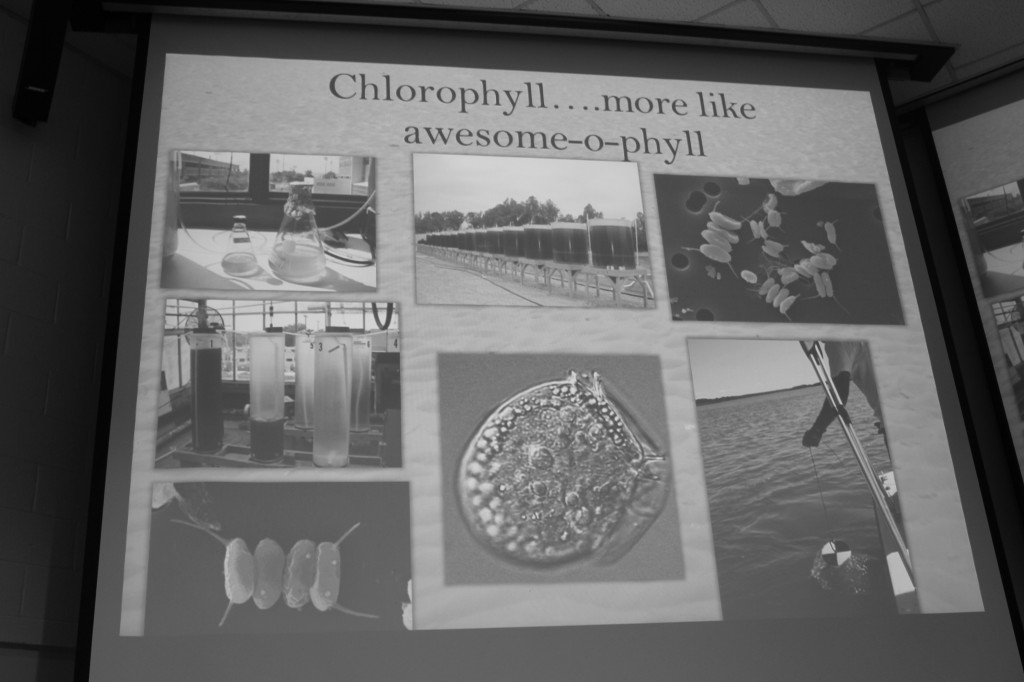

Photo Credit / Jamie Reese
BY ZACHARY GOTTHARDT
SC Staff Writer
On November 1, 2013, Ph.D. candidate and ESU alumnus Matthew Semcheski gave a presentation entitled “Long-term ecological monitoring in Chesapeake Bay (and some other stuff)” in the Moore Biology Building as the last Biocolloquium of the fall semester.
Before he presented his research, Semcheski talked about his past at ESU. Semcheski attended ESU from 2000 to 2003, where he majored in marine science. He also discussed the opportunities that led to his current employment. In 2002, Semcheski earned an internship at the Baltimore Aquarium.
In 2003, he was a counselor and volunteer at the Chesapeake Field Station, now called the Marine Science Consortium, in Wallops Island, Virginia.
Following his graduation from ESU, he enrolled at Old Dominion University as a graduate student and research assistant. His professor encouraged him to work with the DNA of snappers, despite having little interest in the subject. He used his research assistant position, where he worked with phytoplankton, as a mental escape.
In 2005, he took a summer trip to Poland to study limnology (the study of streams), where he continued to foster an interest in phytoplankton.
He admitted hating his graduate study thesis, and the work was painstakingly boring for him. Eventually, he carried his interest in phytoplankton to his current career with the Chesapeake Bay monitoring program.
Semcheski’s work on the Chesapeake Bay is utilized for policy making.
The Chesapeake Bay is the largest estuary in the United States, and his organization monitors all the plankton activity in the bay and its watershed. His job largely consists of collecting plankton samples.
Ideally, these samples are kept alive for identification in the lab. He identifies the species of plankton he finds, occasionally utilizing DNA sequencing and electron microscopy. Semcheski focuses on picoplankton, which are less than two microns long.
In the bay, he has found diatoms, cyanobacteria, chlorophytes and dinoflagellates. With so many species, Semcheski commented that data management and analysis are key factors to his work.
His data is used to monitor the changes in plankton species. In the past, Virginia and the Chesapeake Bay have experienced problems with algal blooms. Algal blooms are harmful to humans and the environment. They can be caused by an increase in temperature and nutrient concentration, either via humans or natural causes, as well as changes in salinity or light intensity.
After the phytoplankton die, a reduction of oxygen will occur, which creates anoxic zones, or “dead zones.” In addition, fish gills can become clogged.
Furthermore, some species produce toxins, which poison the aquatic life and humans who ingest them. The toxins are neurotoxic to humans, which cause damage to the nervous system.
Most of the species responsible for algal blooms are dinoflagellates, which are the focus of most of Semcheski’s work. Dinoflagellates are protists that move via a whirling, whip-like tail.
With his data, Semcheski hopes to predict and detect changes in the prevalence of various plankton species. Government facilities can use the data to appropriately take action to prevent environmental or human harm.
For his Ph.D., Semcheski has analyzed the benthic species of plankton (those which live on the ocean floor) in the Chesapeake Bay.
He wishes to characterize the taxonomy of those species and identify any species that can produce toxins. Benthic species are not identical to the species that he has previously studied, and prevalence of species is dependant upon season, which makes them more difficult to study.
Benthic phytoplankton have not been rigorously studied, but may be a major contributor to algal blooms.
Semcheski and his colleagues have also been hired to assess algal problems worldwide, particularly in Guatemala. Several lakes in Guatemala are in a constant state of bloom.
Algae piles up several inches on the surface of the water, making life impossible for any aquatic organisms.
Following the presentation, Semcheski answered the questions of students and faculty. Their questions ranged from inquiries about graduate school to the specifics of his work.
Email Zachary at:
zgotthar@live.esu.edu

